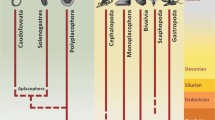Summary
-
1.
Distribution of Alkaline Phosphatase in the brains and digestive tracts of the workers, soldiers and sexuals ofOdontotermes redemanni is specific.
-
2.
During early embryogenesis phosphatase distribution is very uniform and gives no indication of the future caste differentiation.
-
3.
In the advanced larvae three types of reactions are noted. Those with faint, mild and intense phosphatase reactions become soldiers, workers and sexuals respectively.
-
4.
The queen in the «Royal chamber» gives out an exudation through the integument. This exudation is licked and carried by the workers to the undifferentiated larvae in the nurseries. This material has inhibitory or stimulator substance whose selective application sets in the castewise differentiation of the larvae. Once the differentiation is fixed, the larvae show phosphatase reactions specific to the castes into which they will eventually develop.
Similar content being viewed by others
References
Banerjee (B.), 1958. — Cytochemical studies on the oocytes of the termite queenOdontotermes redemanni (Wasmann).Curr. Sci.,27, p. 56–57.—Banerjee (B.), 1964a. Cytogenesis in the ovarioles ofOdontotermes redemanni (Wasmann).La Cellule,64, p. 225–234.—Banerjee (B.), 1964b. Cytochemical localization of Alkaline Phosphatase during early embryogenesis ofOdontotermes redemanni (Wasmann),Naturwissenschaften,51, p. 445–446.—Banerjee (B.), 1965. Studies on the histology and histochemical distribution of phosphatases in the genital tracts ofOdontotermes redemanni (Wasmann).La Cellule,65, p. 151–157.—Banerjee (B.), 1966. A statistical study of the population of the tropical mound building termiteOdontotermes redemanni (Wasmann).Ins. Soc.,13, p. 29–37.
Butler (C. G.), 1964. — Pheromones in sexual processes in insects. InHighnam (K. C.), édit.:Insect Reproduction, p. 66–77. Symposium No. 2. R. ent. Soc. Lond.
Gomori (G.), 1941. — The distribution of phosphatases in normal tissues and organs.J. Cell. Comp. Physiol.,17, p. 71–83.
Harris (W. V.) andSands (W. A.), 1965. — The social organization of termite colonies.Symp. Zool. Soc. Lond.,14, p. 113–131.
Lüscher (M.), 1961. — Social control of polymorphism in termites. InKennedy (J. S.), édit.:Insect Polymorphism, p. 57–67. Symposium No. 1. R. ent. Soc. Lond.
Mukerji (D.) andRaychaudhuri (S. N.), 1943. — On the anatomy of the alimentary system of the termiteTermes redemanni Wasmann.Indian J. Entomol.,5, p. 59–88.
Mukerjt (D.) andBanerjee (B.), 1956. — Thoracic musculature of the alate and de-alate phases of the sexuals of the termiteOdontotermes redemanni (Wasmann).Proc. Indian Sc. Cong.,43, p. 291.
Author information
Authors and Affiliations
Rights and permissions
About this article
Cite this article
Banerjee, B. Distribution of alkaline phosphatase in the castes of the termiteOdontotermes redemanni (Wasmann) and its role in caste formation. Ins. Soc 14, 51–56 (1967). https://doi.org/10.1007/BF02222753
Issue Date:
DOI: https://doi.org/10.1007/BF02222753




